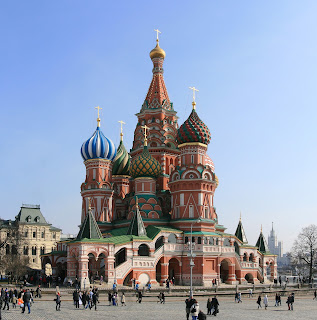10- Alexander Garden
Alexander Gardens was one of the first urban public parks in Moscow, Russia. The park comprises three separate gardens, which stretch along all the length of the western Kremlin wall for 865 metres (2,838 ft) between the building of the Moscow Manege and the Kremlin.
Alexander Garden
History-
After the Napoleonic Wars, Tsar Alexander 1 ordered architect Osip Bove to reconstruct parts of the city which had been destroyed by French troops. Bove laid out a new garden from 1819-1823, on the site of the riverbed of the Neglinnaya River, which was channeled underground.
Riverbed of the Neglinnaya River
Layout-
Upper Garden-
Towards the main entrance to the park is the Tomb of the Unknown Soldier with an eternal flame brought from the Field of Mars in Leningrad. Created in 1967, it contains the body of a soldier who fell during the Great Patriotic War at the kilometer 41 marker of Leningradskoe Shosse, the nearest point the Nazi Germany penetrated towards Moscow. Post Number One, where the honor sentinels stand on guard, used to be located in front of Lenin's Mausoleum, but was moved to the Tomb of the Unknown Soldier in the 1990s.
Main Entrance
The Tomb of the Unknown Soldier
The middle section of the upper garden contains a faux ruined grotto built underneath the Middle Arsenal Tower. Although not constructed in 1841, this was part of Bove's original design. The garden's cast iron gate and grille were designed to commemorate the Russian victories over Napoleon, and its rocks are rubble from buildings destroyed during the French occupation of Moscow.
The Grotto
In front of the grotto is an obelisk erected on July 10, 1914, a year after the tercentenary of the Romanov Dynasty was celebrated. The monument made of granite from Finland listed all of the Romanov Tsars and had the coats of arms of the (Russian) provinces. Four years later, the dynasty was gone, and the Bolsheviks (per lenin's directive on Monumental propaganda) removed the imperial eagle, and re-carved the monument with a list of 19 socialist and communist philosophers and political leaders, personally approved by Lenin.
Originally in the Lower Garden, it was relocated to its present location in 1966. There is discussion to remove Lenin's and reinstall an obelisk duplicating the original.
The wrought iron grille, enclosing this part of the garden, has a design of fasces, which are intended to commemorate the military victory over Napoleon.
The northern part of the garden is adjacent to the large underground shopping complex at Manege Square.
Middle Garden-
The most prominent feature of the Middle Garden is the outlying Kutafya Tower of the Moscow Kremlin. There is an entrance to the park opposite the tower directly to the Moscow Metro system.
Lower Garden-
Laid out in 1823, the Lower Garden stretches to the road leading to the Borovitskaya Tower, one of two vehicular and pedestrian entrances to the Kremlin.
Address- Moscow, Russia
Created- 1823
Status- Open all year
Alexander Gardens was one of the first urban public parks in Moscow, Russia. The park comprises three separate gardens, which stretch along all the length of the western Kremlin wall for 865 metres (2,838 ft) between the building of the Moscow Manege and the Kremlin.
Alexander Garden
History-
After the Napoleonic Wars, Tsar Alexander 1 ordered architect Osip Bove to reconstruct parts of the city which had been destroyed by French troops. Bove laid out a new garden from 1819-1823, on the site of the riverbed of the Neglinnaya River, which was channeled underground.
Riverbed of the Neglinnaya River
Layout-
Upper Garden-
Towards the main entrance to the park is the Tomb of the Unknown Soldier with an eternal flame brought from the Field of Mars in Leningrad. Created in 1967, it contains the body of a soldier who fell during the Great Patriotic War at the kilometer 41 marker of Leningradskoe Shosse, the nearest point the Nazi Germany penetrated towards Moscow. Post Number One, where the honor sentinels stand on guard, used to be located in front of Lenin's Mausoleum, but was moved to the Tomb of the Unknown Soldier in the 1990s.
Main Entrance
The middle section of the upper garden contains a faux ruined grotto built underneath the Middle Arsenal Tower. Although not constructed in 1841, this was part of Bove's original design. The garden's cast iron gate and grille were designed to commemorate the Russian victories over Napoleon, and its rocks are rubble from buildings destroyed during the French occupation of Moscow.
The Grotto
In front of the grotto is an obelisk erected on July 10, 1914, a year after the tercentenary of the Romanov Dynasty was celebrated. The monument made of granite from Finland listed all of the Romanov Tsars and had the coats of arms of the (Russian) provinces. Four years later, the dynasty was gone, and the Bolsheviks (per lenin's directive on Monumental propaganda) removed the imperial eagle, and re-carved the monument with a list of 19 socialist and communist philosophers and political leaders, personally approved by Lenin.
Originally in the Lower Garden, it was relocated to its present location in 1966. There is discussion to remove Lenin's and reinstall an obelisk duplicating the original.
The wrought iron grille, enclosing this part of the garden, has a design of fasces, which are intended to commemorate the military victory over Napoleon.
The northern part of the garden is adjacent to the large underground shopping complex at Manege Square.
Middle Garden-
The most prominent feature of the Middle Garden is the outlying Kutafya Tower of the Moscow Kremlin. There is an entrance to the park opposite the tower directly to the Moscow Metro system.
Lower Garden-
Laid out in 1823, the Lower Garden stretches to the road leading to the Borovitskaya Tower, one of two vehicular and pedestrian entrances to the Kremlin.
Address- Moscow, Russia
Created- 1823
Status- Open all year




































